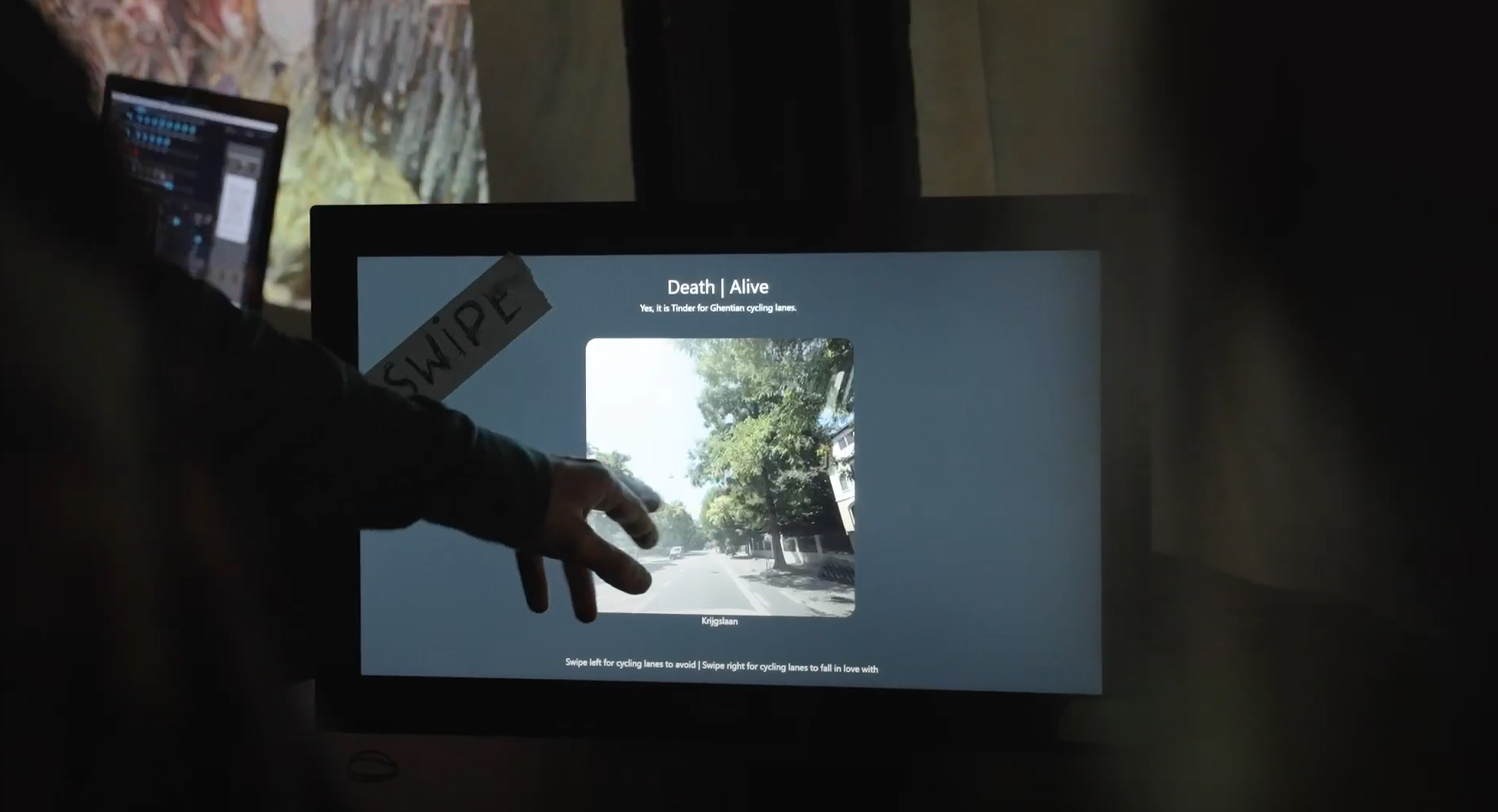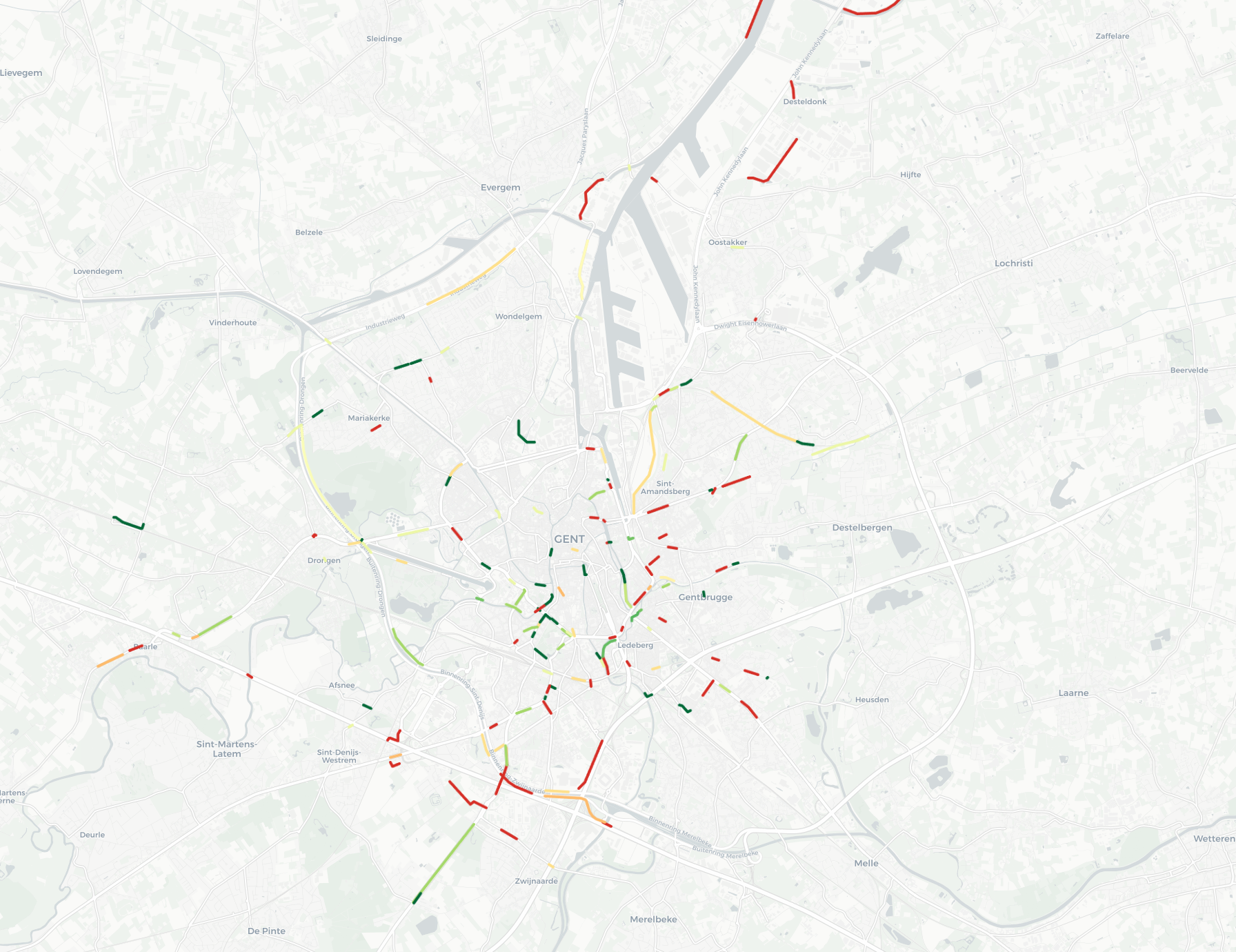Combine the love for cycling with the passion for open data, and you get a new application: Tinder for Cyclists. It’s an application that allows cyclists to vote on bike lanes: swipe left for bad bike lanes, swipe right for the good ones.
As a citizen of Ghent, you can’t ignore it: the love for cycling is generally accepted! From the cycling madness in (’t Kuipke)[https://en.wikipedia.org/wiki/Kuipke] to the overcrowded bike parks at the train stations, the bicycle has found a place within our daily lives. The cycling culture can even be divided into different scenes: amateur cyclists skimming the towpaths on weekends, the young family with the cargo bike and the long-tail bike on their way to school, the commuting speed pedelecers … There are several subcultures within Ghent’s cycling culture. Cycling is alive, especially in Ghent.
Ghent has made great strides in setting up a data portal Dataportal Ghent. In recent years, there has been an idea that data is the new gold. With an open data portal, you give everyone access to that pot of gold: every citizen can get their hands on data to better understand their own city or to raise social issues. Open data, from everyone, for everyone, can contribute to a better society. The City of Ghent is not the first to offer open data: from local authorities to national and European levels, and even giant players like Meta and Google provide open datasets. This allows Ghent’s datasets to be enriched with other datasets.
If there is a Ghent dataset about bike lanes and photos of those bike lanes exist on Facebook’s platform, you can combine that into a new application: “Tinder For Cyclists,” an application that fits within bike-crazy Ghent.
The application
“Tinder for Cyclists” is as simple as the real Tinder: swipe right for good bike paths, swipe left for bad ones. The application contains about a hundred thousand photos of bike paths in Ghent.

An application needs users. BYOB by Nerdlab is the ideal platform for this. During the event BYOB - Bring Your Own Beamer - you get a white canvas on which you may project whatever you want. Visitors get to see a range of installations, short films, and digital art in one evening. “Tinder for Cyclists” may not be digital art, but it also got a place within BYOB. This completes the circle: a Ghent dataset that Ghenters can use to vote for good and bad Ghent bike paths.
Is Ghent a match?
The dataset does not include all of Ghent’s bike lanes; it includes only the “intercity” bike lanes: a bike path you use to get in and out of Ghent. All bike lanes within the dataset are scored: 1/10 is solidly failed, 10/10 is the primus of the class. BYOB visitors were the judges: 57% of the scores were negative, 43% were positive. You can see the results on the map: red bike lanes failed, green bike lanes are heaven on earth for Ghent cyclists.
 The interactive version can be found here terug te vinden.
The interactive version can be found here terug te vinden.
The contest for the most “bike-friendly street” has winners and losers. A recurring element among the losers is the mention of “steenweg” (chaussee) in their street name. This confirms the sentiment.
| Top 5 | Score | Bottom 5 | Score | |
|---|---|---|---|---|
| 1. Groenestaakstraat | 10.0 | 1. Grotesteenweg-Noord | 2.7 | |
| 2. Ijzerlaan | 7.2 | 2. Hundelgemsesteenweg | 3.1 | |
| 3. Visserij | 7.2 | 3. Motorstraat | 3.6 | |
| 4. Grotesteenweg-Zuid | 6.9 | 4. Oudenaardsesteenweg | 3.8 | |
| 5. Stropkaai | 6.5 | 5. Kortrijksesteenweg | 3.8 |
What now?
Is this a statistical study that correctly addresses major social problems scientifically? Obviously not. Is this an attempt to promote open data as a policy tool? Yes indeed.
Our society is facing major issues: climate change, aging, … Companies and governments can support this by opening up their data: to individuals, companies, and research groups alike. We might just arrive at new insights.
The application itself is not (yet) online. The idea is being played with to extend the application to all bike paths in Ghent.
Credits
- Nerdlab Gent (Organiser of Bring Your Own Beamer - BYOB)
- Dataset Ghent city-regional bicycle network from Open Data Portaal Gent
- Bavo De Kuysscher (Real-time map visualization in Blender)
- Vincent Henau (Development of the frontend)
- Ruben Boidin (Picture installation on BYOB)
- Cato Van Heuven (First class proofreading)